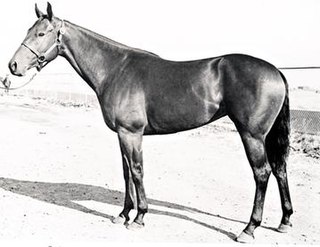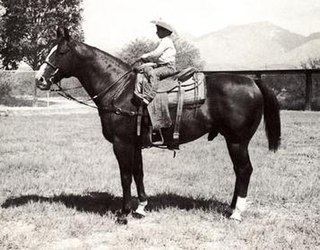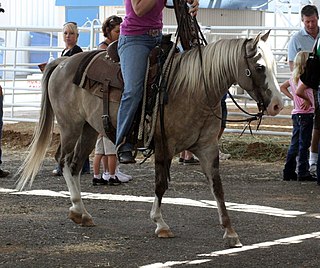
The American Quarter Horse, or Quarter Horse, is an American breed of horse that excels at sprinting short distances. Its name is derived from its ability to outrun other horse breeds in races of 1⁄4 mi (0.40 km) or less; some have been clocked at speeds up to 44 mph (71 km/h). The development of the Quarter Horse traces to the 1600s.

The American Paint Horse is a breed of horse that combines both the conformational characteristics of a western stock horse with a pinto spotting pattern of white and dark coat colors. Developed from a base of spotted horses with Quarter Horse and Thoroughbred bloodlines, the American Paint Horse Association (APHA) breed registry is now one of the largest in North America. The registry allows some non-spotted animals to be registered as "Solid Paint Bred" and considers the American Paint Horse to be a horse breed with distinct characteristics, not merely a color breed.

The Azteca is a horse breed from Mexico, with a subtype, called the "American Azteca", found in the United States. They are well-muscled horses that may be of any solid color, and the American Azteca may also have Paint coloration. Aztecas are known to compete in many western riding and some English riding disciplines. The Mexican registry for the original Azteca and the United States registries for the American Azteca have registration rules that vary in several key aspects, including ancestral bloodlines and requirements for physical inspections. The Azteca was first developed in Mexico in 1972, from a blend of Andalusian, American Quarter Horse and Mexican Criollo bloodlines. From there, they spread to the United States, where American Paint Horse blood was added.

Go Man Go (1953–1983) was an American Quarter Horse stallion and race horse. He was named World Champion Quarter Running Horse three times in a row, one of only two horses to achieve that distinction. Go Man Go was considered to be of difficult temperament. While waiting in the starting gate for his first race, he threw his jockey, broke down the gate, and ran alone around the track; he was eventually caught and went on to win the race. During his five years of competition until he retired from racing in 1960 he had 27 wins, earning more than $86,000.

Joe Hancock (1926–1943) was an influential Quarter Horse sire in the early years of the American Quarter Horse Association.
Joe Reed II (1936–1964) was a Quarter Horse racehorse from the early days of the American Quarter Horse Association that became an influential sire with the breed.
Joe Reed (1921–1947), often known as Joe Reed P-3, was a Quarter Horse racehorse from the early days of the American Quarter Horse Association that became an influential sire with the breed.
King (1932–1958), often known as King P-234, was an outstanding early Quarter Horse stallion who influenced the breed throughout the early years of the American Quarter Horse Association.
Bert (1934—1956) was one of the most influential sires in the early years of the American Quarter Horse Association (AQHA). He was posthumously inducted into the AQHA Hall of Fame.
Clabber (1936–1947) was a Quarter Horse stallion known as the Iron Horse for his ability to run and win match races after a day of ranch work.
Driftwood (1932–1960) was originally known as Speedy while he was a rodeo horse. Driftwood was known for siring rodeo and ranch horses.
For many years, Oklahoma Star (1915–1943) was known simply as the Tommy Moore Horse, after his breeder, owner, trainer and race jockey. He was an influential Quarter Horse stallion in the early days of the breed.
Old Sorrel, sometimes known as The Old Sorrel (1915–1945), was a Quarter Horse stallion who was the foundation of the King Ranch linebreeding program for Quarter Horses, and the cornerstone of the King Ranch horse breeding program.
Baby Doll Combs (1947–1960) was a registered Quarter Horse mare and a prominent rodeo horse. She was posthumously inducted into the AQHA Hall of Fame and the ProRodeo Hall of Fame.

Barbara L (1947–1977) was an American Quarter Horse that raced during the early 1950s and often defeated some of the best racehorses of the time. She earned $32,836 on the race track in 81 starts and 21 wins, including six wins in stakes races. She set two track records during her racing career. After retiring from racing in 1955, she went on to become a broodmare and had 14 foals, including 11 who earned their Race Register of Merit with the American Quarter Horse Association (AQHA). Her offspring earned more than $200,000 in race money. She died in 1977 and was inducted into the AQHA's American Quarter Horse Hall of Fame in 2007.
Texas Dandy was a Quarter Horse stallion who not only raced well, and sired outstanding broodmares, he was a movie star also.
Shue Fly (1937–1963) was a Quarter Horse mare who was one of the dominant racehorses on the racetrack during the 1940s.
The American Paint Horse Association (APHA) is a breed registry for the American Paint Horse. It is currently headquartered in Fort Worth, Texas. It was founded in 1965 with the merging of two different color breed registries that had been formed to register pinto-colored horses of Quarter Horse bloodlines. One of these organizations was the American Paint Quarter Horse Association and the other was the American Paint Stock Horse Association.

Lightning Bar (1951–1960) was an American Quarter Horse who raced and subsequently became a breeding stallion. He was bred by his lifelong owner Art Pollard of Sonoita, Arizona, and was the offspring of Three Bars, a Thoroughbred, and Della P, a Quarter Horse mare from Louisiana, then noted for the breeding of sprint horses. Lightning Bar raced ten times, achieving four victories and four other top-three finishes. His racing career was cut short by illness after only one year, following which he spent two years as a show horse. As a breeding stallion, he sired seven crops, or years, of foals, among whom Doc Bar was the best known. In 1960 Lightning Bar died of an intestinal infection at the age of nine. He was inducted into the American Quarter Horse Association's (AQHA) Hall of Fame in 2008.

The Quarter Pony is a breed of pony that is similar to the American Quarter Horse. It stands up to 14.2 hands high and was developed from American Quarter Horse foundation bloodstock. The breed was originally developed from Quarter Horses that did not meet the American Quarter Horse Association's height requirement. It is bred to look like a small Quarter Horse, although the various registries also allow crosses with other breeds, including Paint horse, Appaloosa and Pony of the Americas, all stock types. It is one of the most versatile horse breeds there are. There are three registries for the Quarter Pony, all with slightly different registration requirements. The first registry was begun in 1964, and two more were started in the 1970s. The breed is used today in a variety of Western and English riding disciplines.









